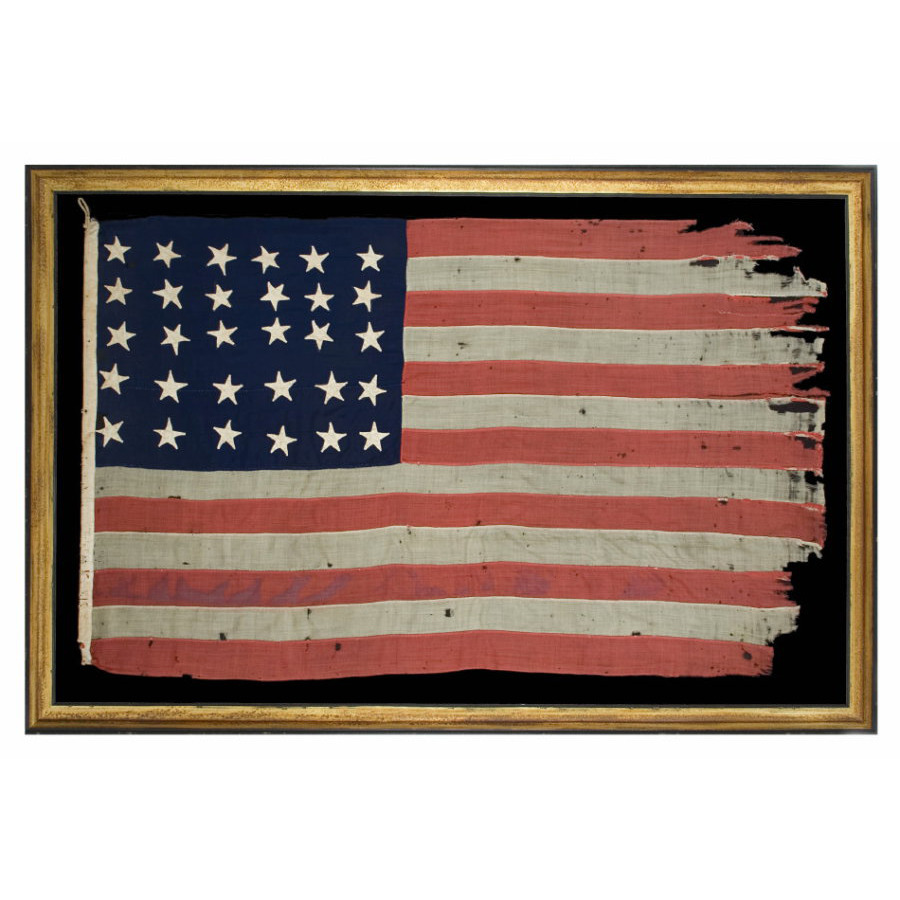
| |
30 STARS, WISCONSIN STATEHOOD, 1848-1850, A PRE-CIVIL WAR EXAMPLE WITH WONDERFUL GRAPHIC FEATURES |
|
| Available: |
Sold |
| Frame Size (H x L): |
58" x 89" |
| Flag Size (H x L): |
46.5" x 78" |
|
| Description....: |
|
30 STARS, WISCONSIN STATEHOOD, 1848-1850, A PRE-CIVIL WAR EXAMPLE WITH WONDERFUL GRAPHIC FEATURES:
Entirely hand-sewn, 30 star American national flag with crude and whimsical graphic features and endearing wear from obvious extended use. Note how the narrow, spur-like arms of its flat-tipped stars is accentuated by the fact that they are oriented in a various directions on their vertical axis. Also note how the maker attempted to make place them in lineal rows, but the result was haphazard at best. The combination of these attributes lend a strong folk quality and bold visual statement to the flag's design.
The 30th state, Wisconsin, joined the Union on May 29th, 1848. The 30 star flag was official until July 3rd, 1851, but 30 star flags would not likely have been made following the addition of California in 1850. Flag-makers paid little heed to official star counts unless required by the person(s) requesting that flags be produced to some particular design. While the Flag Act of 1818 dictated that the star count would officially change on the 4th of July following the date of a state's acceptance, stars were generally added by the makers of flags when the state was added (sometimes even beforehand). This means that the 30 star flag had a realistic window of production of just over two years.
Flags made prior to the Civil War comprise less than one percent of 19th century flags that have survived into the 21st century. Prior to the Confederate attack on Fort Sumter, the Stars & Stripes was simply not used for most of the same purposes we employ it in today. Private individuals did not typically display the flag in their yards and on their porches. Parade flags didn't often fly from carriages and horses. Places of business rarely hung flags in their windows. Private use of the national flag rose swiftly during the patriotism that accompanied the Civil War, then exploded in 1876.
Even the military did not use the flag in a manner that most people might think. The primary purpose before the Civil War was to mark ships on the open seas. While the flag was used to mark some garrisons, the flags of ground troops were often limited to the flag of their own regiment and a Federal standard. Most people would be surprised to learn that the infantry wasn't authorized to carry the Stars & Stripes until 1837. Even then it was neither required nor customary. It was not until the Civil War took place that most U.S. ground forces carried the national flag.
The canton and stripe of the flag are made of wool bunting. The stars are made of cotton and double-appliqued (applied to both sides). There is a fine linen sleeve through which a rope is threaded for hoisting.
The most likely purpose of the flag was for nautical use. This was the most common purpose for a flag in this size and manner of construction prior to the Civil War. The combination of its graphics, early date, hand-sewn construction, and narrow window of production result in a great example of the period.
Mounting: The flag has been hand-stitched to 100% silk organza for support. It was then hand-sewn to a background of 100% cotton twill, black in color, which was washed to reduce excess dye. And acid-free agent was added to the wash to further set the dye and the fabric was heat-treated for the same purpose. The mount was then placed in a black-painted, hand-gilded and distressed, Italian molding. The glazing is U.V. protective Plexiglas.
Condition: The flag shows obvious signs of use, with fabric loss at the fly end and elsewhere, accompanied by foxing and some staining, particularly on the 6th red stripe. Even today with modern materials, flags used at sea are not generally expected to last more than a few months. In the mid-19th century, the expected lifespan would have been shorter, which also helps to explain why the condition of this flag is both common and very much acceptable. Many of my clients prefer early flags to show their age and history of use. |
|
|
|
| Collector Level: |
Advanced Collectors and the Person with Everything |
|
| Flag Type: |
Sewn flag |
|
| Star Count: |
30 |
|
| Earliest Date of Origin: |
1848 |
|
| Latest Date of Origin: |
1850 |
|
| State/Affiliation: |
Wisconsin |
|
| War Association: |
1777-1860 Pre-Civil War |
|
| Price: |
SOLD |
|
| |
Views: 3036 |
|
|
|

